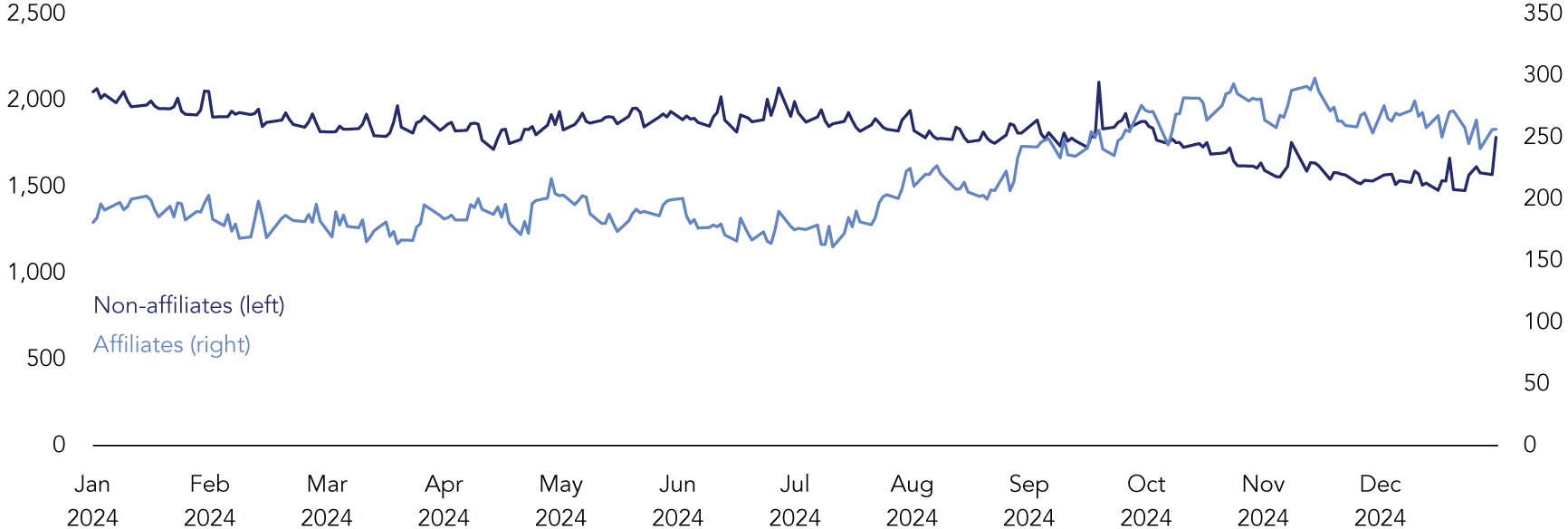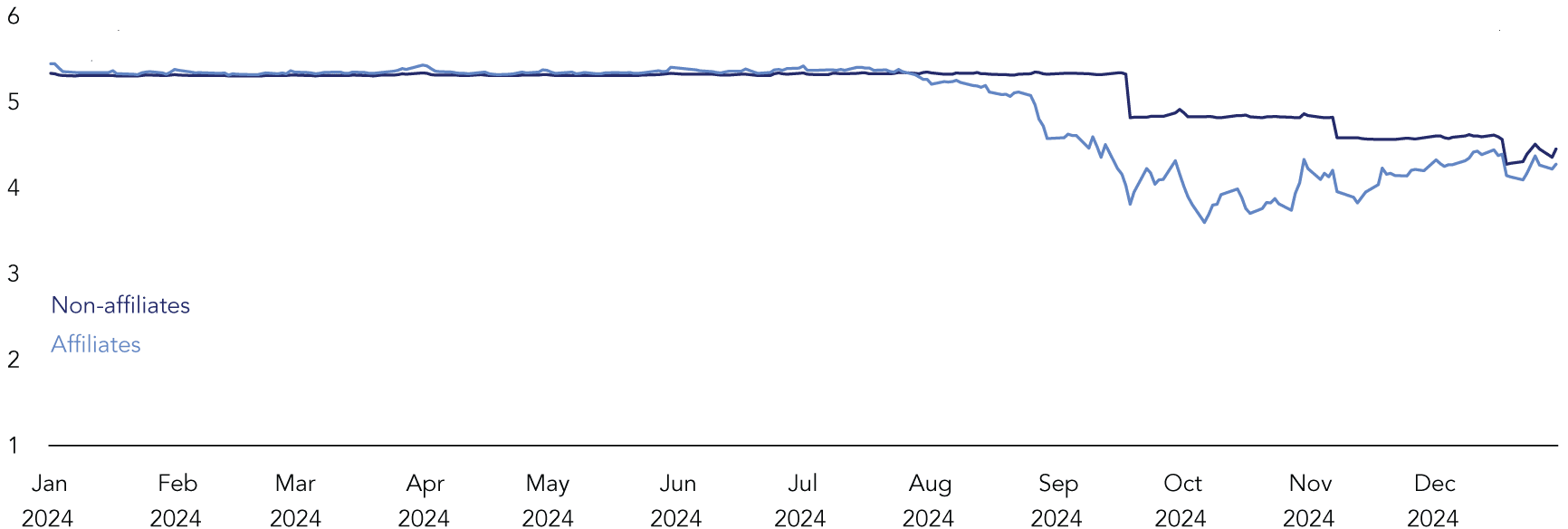Affiliate Repo and the 2024 STFM Update
Published: August 7, 2025
Views expressed are those of the authors and do not necessarily represent official positions or policy of the Office of Financial Research or the U.S. Department of the Treasury.
The OFR Short-term Funding Monitor (STFM) provides important insights into the repurchase agreement (repo) market. This market provides safe, short-term investment opportunities for cash investors and is used by financial institutions to source funding and borrow securities. The STFM tracks key metrics like transaction volumes and interest rates that provide policymakers and market participants with a comprehensive view of repo market conditions. The OFR occasionally adjusts the STFM methodology in response to market changes. In late 2024, the OFR updated certain published statistics included in the STFM to exclude affiliate repo trades, which are repo trades that occur between counterparties that are legally distinct entities controlled by the same bank holding company or parent financial institution.
The repo market allows U.S. dealers to borrow cash by pledging high-quality securities, often U.S. Treasuries, as collateral. Lenders tend to be non-affiliated financial institutions or other dealers. However, a dealer may also obtain funding through affiliated institutions, such as commercial banks, foreign dealers, or money market funds. In such cases, transaction rates may reflect internal considerations for a financial institution rather than market dynamics.
Affiliate repo rates shaped by non-economic factors can materially influence the rates reported in the OFR STFM. When these rates diverge from market levels and the associated trades are sufficiently large, they may distort the STFM’s representation of market pricing and liquidity.
The STFM currently contains information about three repo market segments or venues: two centrally cleared U.S. repo market segments, DVP and GCF, and one non-centrally cleared third-party managed segment (tri-party). While affiliate repos can occur in any of these three segments, the majority occurs in the tri-party segment likely due to the additional cost of central clearing. For this reason, some STFM charts and metrics that track the tri-party segment have been updated to exclude transactions between affiliated counterparties, as of July 2024. The OFR will continue to monitor developments in affiliate trading in all segments.
Affiliate repos comprise less than 2% of average daily transactions in tri-party but they account for 10% of average daily repo transaction volume (see Table 1). The average trade size is significantly larger for affiliate repos, which suggests that affiliate repos may be concentrated in a small set of trades and on a few dates. In addition, because affiliate repos tend to be longer term (that is, have longer tenors), the dealers’ outstanding exposure to these transactions may be higher than the daily average transaction volume implies.
Table 1. 2024 Daily Average of Affiliate Versus Non-Affiliate Tri-Party Repo Transactions
| Transactions | Volume | Trade Size | Tenor | |||
|---|---|---|---|---|---|---|
| Units | Number | Percent | $ Billions | Percent | $ Millions | Days |
| Non-Affiliate | 4,100.6 | 98.1 | 1,816.7 | 89.4 | 443.3 | 5.1 |
| Affiliate | 79.2 | 1.9 | 214.0 | 10.6 | 2,806.3 | 7.7 |
Sources: Federal Reserve Tri-Party Repo Collection, Authors’ analysis.
In the middle of 2024, affiliate trading began to increase substantially in the tri-party segment, reaching levels not seen since early 2023. During the first half of the year, daily average affiliate volume stayed approximately constant at $200 billion and accounted for about 10% of total daily transaction volume (see Figure 1). However, during the second half of the year, daily average affiliate volume increased 50% to $300 billion while non-affiliate volume declined. By the end of the year, the affiliate volume was approximately 17% of total daily transaction volume, which was a substantial increase.
Figure 1. Daily Transaction Affiliate vs. Non-Affiliate Volume

Sources: Federal Reserve Tri-Party Repo Collection, Authors’ analysis.
Much of the new volume was completed at interest rates far below prevailing rates. Figure 2 shows volume-weighted median non-affiliate and affiliate repo rates during 2024. During the first half of the year, rates on non-affiliate and affiliate repos stayed roughly around the Secured Overnight Financing Rate (SOFR). However, during the second half of the year, rates on affiliate repos declined dramatically, at times falling more than 100 basis points below SOFR.
Figure 2. Daily Median Affiliate vs. Non-Affiliate Rates

Sources: Federal Reserve Tri-Party Repo Collection, Authors’ analysis.
Figure 3 compares the STFM tri-party average rate with and without affiliate trades, with data as of January 2025. The approximately 0.5 percentage point drop in both series in September 2024 reflects the 0.5 percentage point cut in the target range of the federal funds rate announced after the September FOMC meeting.
Figure 3. Tri-Party Average Rate with and without Affiliates

Note: Data in the STFM are currently updated through Q3 2024. Future updates will reflect the methodological change discussed in the blog.
Sources: OFR Short-Term Funding Monitor, Authors’ analysis.
Affiliate trades have been removed from the tri-party rate calculations from July 2024 onward. This change will create a rates series that better reflects market conditions. The OFR will continue to assess the economic factors at play with affiliate repos to provide more context for the 2024 trends.